War of the Spanish Succession
The War of the Spanish Succession (1701–1714) was a European conflict of the early 18th century, triggered by the death of the childless Charles II of Spain in November 1700. His closest heirs were members of the Austrian Habsburg and French Bourbon families; acquisition of an undivided Spanish Empire by either threatened the European balance of power.
Charles left an undivided Spanish monarchy [lower-alpha 4] to Louis XIV's grandson Philip who was proclaimed King of Spain on 16 November 1700. Disputes over the separation of the Spanish and French crowns, division of territories and commercial rights led to war in 1701 between the Bourbons of France and Spain and the Grand Alliance, whose candidate was Archduke Charles, younger son of Emperor Leopold.[lower-alpha 5]
By the end of 1706, Allied victories in Italy and the Low Countries forced the French back within their borders but they were unable to make a decisive breakthrough. Control of the sea allowed the Allies to conduct successful offensives in Spain, but the lack of popular support for Archduke Charles meant they could not hold territory outside the coastal areas.
When the Hapsburg Emperor Joseph died in 1711, Charles succeeded him as Emperor; since a key objective for all parties was preventing the union of Spain with either France or Austria, this rendered fighting in this theatre largely irrelevant. Increasing discontent at the war's cost resulted in the election in 1710 of a new British government committed to ending it. As Britain was now the major source of funding for the Allied war effort, the others were also forced to make peace, resulting in the 1713 Treaty of Utrecht, followed in 1714 by the treaties of Rastatt and Baden.
In return for confirmation as King of Spain, Philip V renounced his place in the line of succession to the French throne, both for himself and his descendants; Spain retained the bulk of its possessions outside Europe, while its territories in Italy and the Netherlands were divided between Austria, Britain and Savoy. The Dutch Republic was granted its Barrier Fortresses, while France acknowledged the Protestant succession in Britain and agreed to end support for the Stuart exiles.
In the longer term, the commercial provisions of Utrecht confirmed Britain's status as the leading European maritime and commercial power. Others included the decline of the Dutch Republic as a first-rank power, the creation of a centralised Spanish state and the acceleration of the break-up of the Holy Roman Empire into larger and more powerful German principalities.[2]
Background

In 1665 Charles II became the last male Habsburg King of Spain; suffering from ill-health all his life, his death was anticipated almost from birth and his successor debated for decades. In 1670, England agreed to support the rights of Louis XIV to the Spanish throne in the Treaty of Dover, while the terms of the 1688 Grand Alliance committed England and the Dutch Republic to back Leopold.[3]
In 1700, the Spanish Empire included possessions in Italy, the Spanish Netherlands, the Philippines and the Americas and though no longer the dominant great power, it remained largely intact.[4] Since acquisition of the Empire by either the Austrian Habsburgs or French Bourbons would change the balance of power in Europe, its inheritance led in a war that involved most of the European powers. The 1700-1721 Great Northern War is considered a connected conflict, since it impacted the involvement of states such as Sweden, Saxony, Denmark–Norway and Russia.[5]
During the 1688-1697 Nine Years War, armies had increased in size from an average of 25,000 in 1648 to over 100,000 by 1697, a level unsustainable for pre-industrial economies.[6] The 1690s also marked the lowest point of the Little Ice Age, a period of colder and wetter weather that drastically reduced crop yields.[7] The Great Famine of 1695-1697 killed between 15-25% of the population in present-day Scotland, Estonia, Finland, Latvia, Norway and Sweden, with an estimated two million deaths in France and Northern Italy. [8]
The 1697 Treaty of Ryswick was therefore the result of mutual exhaustion and Louis XIV's acceptance that France could not achieve its objectives without allies. Leopold initially refused to sign and did so with extreme reluctance in October 1697; by now, Charles' health was clearly failing and with the Succession unresolved, the signatories viewed Ryswick as a pause in hostilities.[9]
Partition treaties
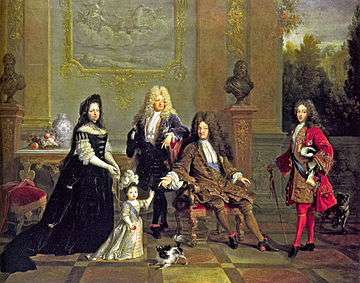
Unlike France or Austria, the Crown of Spain could be inherited through the female line. This allowed Charles' sisters Maria Theresa (1638–1683) and Margaret Theresa (1651–1673) to pass their rights as rulers onto the children of their respective marriages with Louis XIV and Emperor Leopold.
Despite being opponents in the recent Nine Years War, Louis XIV and William III of England now attempted to resolve the Succession by diplomacy.[10] In 1685, Maria Antonia (1669–1692), daughter of Leopold and Margaret, married Maximillian Emanuel of Bavaria and they had a son, Joseph Ferdinand. The 1698 Treaty of the Hague or First Partition Treaty between France, Britain [lower-alpha 6] and the Dutch Republic made the six year old heir to the bulk of the Spanish Monarchy and divided its European territories between France and Austria.[11]

The Spanish refused to accept the division of their Empire and on 14 November 1698, Charles published his Will, making Joseph Ferdinand heir to an independent and undivided Spanish monarchy.[12] When he died of smallpox in February 1699, a new solution was required; this was provided by his mother Maria Antonia, who in 1685 transferred her claim to the Spanish throne to Leopold's sons, Joseph and Archduke Charles.[13] This was of doubtful legality but France, Britain and the Netherlands used it to devise the 1700 Treaty of London; Archduke Charles became the new heir, with Spanish possessions in Europe split between France, Savoy and Austria.[14]
Leopold refused to agree the provisions of the Treaty giving France most of Italy while Spain continued to insist on an undivided monarchy.[15] Charles amended his Will in favour of Archduke Charles but on 2 October, replaced him with Louis' grandson Philip, Duke of Anjou.[16] If Philip refused, his younger brother, the duc de Berry was next, followed by Archduke Charles.
Charles died on 1 November 1700 and Louis received the offer on 9th, giving him the option to accept or insist on the Treaty of London. The latter would in theory give the throne to Archduke Charles but if Leopold continued to refuse the territorial concessions, Louis could demand Britain and the Dutch join him in enforcing the Treaty, leaving Austria isolated. However, French diplomats advised the anti-French mood of the Hapsburg court meant war either way, while Britain and the Dutch would neither fight for or against Austria.[17] On balance, this made it preferable to accept the offer and on 16 November, Philip of Anjou was proclaimed Philip V of Spain.
Prelude to war
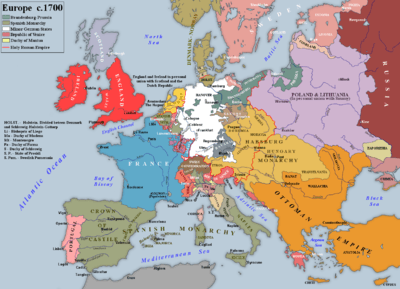
With most of his objectives achieved by diplomacy, Louis now made a series of moves that combined to make war inevitable.[18] The Tory majority in the English Parliament would not fight for Spain or the Dutch and preferred the provisions of Charles' will to the Partition Treaties.[lower-alpha 7][19] However, a foreign diplomat observed this was true 'so long as English commerce does not suffer.'[20] Louis either failed to appreciate this or decided to ignore it and his actions gradually eroded Tory opposition.[21]
In early 1701, Louis registered Philip's claim to the French throne with the Paris Parlement, raising the possibility of union with Spain, contrary to Charles' will. In February, the Spanish-controlled Duchies of Milan and Mantua in Northern Italy announced their support for Philip and accepted French troops. Combined with efforts to build an alliance between France and Imperial German states in Swabia and Franconia, these were challenges Leopold could not ignore.[22]
At the same time, French garrisons took over Dutch-held 'Barrier' fortresses in the Spanish Netherlands, helped by the Spanish Viceroy and French ally Max Emanuel of Bavaria.[23] This undid Dutch gains made at Ryswick and threatened their lucrative monopoly over the Scheldt granted by the 1648 Peace of Münster.[24] It was also a concern to English merchants since control of the ports of Antwerp and Ostend allowed France to blockade the Channel at will. Combined with other French actions potentially damaging to English trade, this produced a clear majority for war and in May 1701, Parliament urged William to negotiate an anti-French alliance.[25]
On 7 September, Leopold, the Dutch Republic and Britain[lower-alpha 8] signed the Treaty of The Hague renewing the 1689 Grand Alliance. Its provisions included securing the Dutch Barrier in the Spanish Netherlands, the Protestant succession in England and Scotland and an independent Spain but made no reference to placing Archduke Charles on the Spanish throne.[26]
War became inevitable when the exiled James II died on 16 September and Louis reneged on his earlier recognition of the Protestant William III as King of England and Scotland by acknowledging the Catholic Stuart heir, James Francis Edward as King. When William died in March 1702, his successor Queen Anne confirmed her continuation of securing the Protestant succession and resisting French expansion. The Dutch did the same and on 15 May the Grand Alliance declared war on France, followed by the Imperial Diet on 30 September.[27]
Key strategic drivers

Economic: The importance of trade and economic interests to the participants is often under estimated; contemporaries viewed Dutch and English support for the Habsburg cause as primarily driven by a desire for access to the Spanish American markets.[28]
Modern economics generally assumes a constantly growing market whereas the then dominant theory of Mercantilism viewed it as static. As a result, increasing your share of trade implied taking it from someone else, with the government's role being to restrict foreign competition.[29] Trade was often used as a policy weapon; between 1690-1704, English import duties increased by 400%, while the 1651-1663 Navigation Acts were a major factor in the Anglo-Dutch Wars. On 6 September 1700, France banned the import of English manufactured goods like cloth and imposed prohibitive duties on a wide range of others.[30]
Military: the armies engaged in the Nine Years War often exceeded 100,000 men and proved too large for the pre-industrial economies of its participants.[31] Those of 1701-1714 averaged around 35,000 - 50,000 but a dependence on water-borne transport accentuated the importance of rivers like the Rhine in Germany or the Adda in Northern Italy. Reliance on the local countryside for resupply limited operations in poor areas like Northern Spain; these factors confined campaigns to the same general areas.[lower-alpha 9]
War aims and major parties
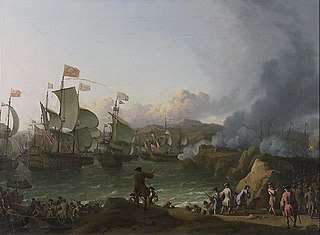
Britain (England and Scotland pre-1707)
Alignment on reducing the power of France and securing the Protestant succession masked differences on how to achieve them. In general, the Tories favoured a mercantilist strategy of using the Royal Navy to attack French and Spanish trade while protecting and expanding their own; land commitments were viewed as expensive and primarily of benefit to others.[32] The Whigs argued France could not be defeated by seapower alone, making a Continental strategy essential. Britain's financial strength made it the only member of the Alliance able to operate on all fronts against France.[33]
The Dutch Republic
The Dutch provided much of the manpower for the campaigns in the Low Countries; while Marlborough was accepted as the Allied commander, in the early years strategy in that theatre was subject to their approval. Dutch priorities were to re-stablish and strengthen the Barrier fortresses, retain control of the Scheldt estuary and gain access to trade in the Spanish Empire.
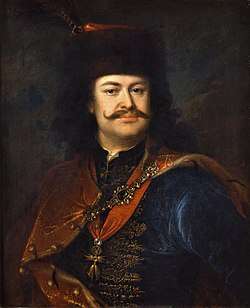
Austria/ The Holy Roman Empire
Despite Austria being the seat of the Holy Roman Empire, Austrian and Imperial interests did not always coincide. For much of the war, the Austrian Habsburgs focused on securing their southern borders in northern Italy and suppressing Rákóczi's War of Independence in Hungary. Putting Archduke Charles on the Spanish throne was not an explicit objective for them. The crucial campaign in Spain was reliant on the so-called "Maritime Powers" (England and the Dutch Republic) and also a higher priority for them.
By formalising religious divisions within the Empire, the 1648 Peace of Westphalia weakened its integrity and by 1700, the larger German states were pursuing their own policies. Bavaria allied itself with France while as King of Poland, Augustus of Saxony was fully occupied by the Great Northern War. To gain Frederick of Prussia's support, Leopold recognised him as King, with Prussia made an equal member of the Grand Alliance.[lower-alpha 10] Elector George of Hanover was more reliable, given his position as heir to the British throne but the suspicion remained the interests of Hanover came first.[34] The role played by many of the minor German states and neutrals like Denmark was primarily in hiring out their troops to members of the Grand Alliance.
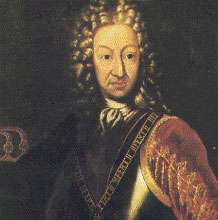
France Under Louis XIV, France was the most powerful state in Europe with revenue-generating capacities that far exceeded its rivals. Its geographical position provided enormous tactical flexibility, unlike Austria it had its own navy and as the campaigns of 1708-10 proved, even under severe pressure it could defend its borders. The Nine Years War had shown France could not impose its objectives without support but the alliance with Spain and Bavaria made a successful outcome far more likely. Apart from denying an undivided Spanish Monarchy to others, Louis' objectives were to secure his borders with Germany, weaken Austria and increase French commercial strength by access to the Americas trade.
Spain Their key objective was as far as possible to preserve an undivided and independent Monarchy. During the 17th century, a series of wars with France drained military and financial resources, with the economy subject to long periods of low productivity and depression.[35] The Spanish monarchy was a personal union of the Crowns of Castile and Aragon, [lower-alpha 11] each with very different political cultures.[36] The combination of weak central control, war and a depressed economy meant government finances were in perpetual crisis.
Savoy During the Nine Years War, Savoy joined the Grand Alliance in 1690 before agreeing a separate peace with France in 1696. The Duchy was strategically important as it provided access to the southern borders of Austria and France. Philip's accession as King of Spain in 1701 placed Savoy between the Spanish-ruled Duchy of Milan and France, while the Savoyard County of Nice and County of Savoy were in Transalpine France and very difficult to defend.
Victor Amadeus II allied with France in 1701 but his long-term goal was the acquisition of Milan; neither France, Austria or Spain would relinquish this voluntarily, leaving Britain as the only power that could. After the Royal Navy established control over the Western Mediterranean in 1703, Savoy changed sides.
Military campaigns 1701–1708
Italy
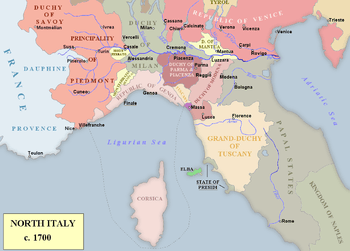
The war was fought over the Spanish-ruled Duchies of Milan and Mantua in Northern Italy considered essential to the security of Austria's southern borders. In 1701, French garrisons occupied Milan and Mantua and Victor Amadeus II, Duke of Savoy, allied with France, his daughter Maria Luisa marrying Philip V.[37] In May 1701, an Imperial army under Prince Eugene of Savoy moved into Northern Italy; by February 1702, victories at Carpi, Chiari and Cremona forced the French behind the Adda river.[38]

Vendôme, one of the best French generals, took command and was substantially reinforced; Prince Eugene managed a draw at the Battle of Luzzara but the French recovered most of the territory lost the year before.[39] In October 1703, Victor Amadeus declared war on France; by May 1706, the French held most of Savoy except Turin while victories at Cassano and Calcinato forced the Imperialists into the Trentino valley[40]
However, in July 1706 Vendôme and any available forces were sent to reinforce France's northern frontier after the defeat at Ramillies. Reinforced by German auxiliaries, Prince Eugene marched on Turin and the siege was broken by the Battle of Turin on 7 September. Despite a minor French victory at Castiglione, the war in Italy was over; the Convention of Milan in March 1707 confirmed Austria's control of Milan and Mantua, with French troops given free passage back to France for redeployment elsewhere.[41]
An attack by forces from Italy on the French base of Toulon was planned for 1707 but was postponed when 10,000 Imperial troops were diverted in June to seize the Spanish Bourbon Kingdom of Naples.[lower-alpha 12] The delays contributed to the failure of the siege of Toulon; by the end of 1707, fighting in Italy ceased apart from attempts by Victor Amadeus to recover his trans-Alpine territories of Nice and Savoy.[lower-alpha 13][42]
Low Countries, Rhine and Danube

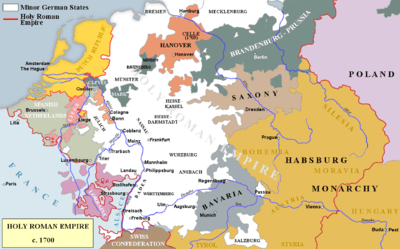
The first objective for the Grand Alliance in this theatre was to secure the Dutch frontiers, threatened by the alliance between France, Bavaria and Joseph Clemens, ruler of Liège and Cologne. During 1702, the Barrier fortresses were retaken along with Kaiserswerth, Venlo, Roermond and Liège.[43] The 1703 campaign was marred by Allied conflicts over strategy; they failed to take Antwerp, while the Dutch defeat at Ekeren in June led to bitter recriminations.[44]
On the Upper Rhine, Imperial forces under Louis of Baden remained on the defensive, although they took Landau in 1702. Over the course of 1703, French victories at Friedlingen, Höchstädt and Speyerbach with the capture of Kehl, Breisach and Landau directly threatened Vienna.
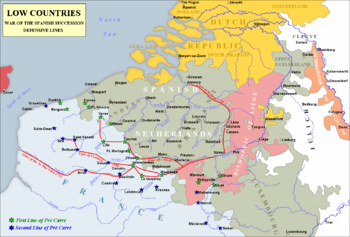
In 1704, Franco-Bavarian forces continued their advance with the Austrians struggling to suppress Rákóczi's revolt in Hungary.[45] To relieve the pressure, Marlborough marched up the Rhine, joined forces with Louis of Baden and Prince Eugene and crossed the Danube on 2 July. Allied victory at Blenheim on 13 August forced Bavaria out of the war and the Treaty of Ilbersheim placed it under Austrian rule.[lower-alpha 14][46]
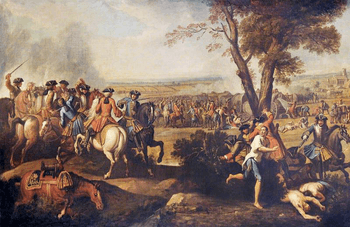
Allied efforts to exploit their victory in 1705 foundered on poor co-ordination, tactical disputes and command rivalries, while Leopold's ruthless rule in Bavaria caused a brief but vicious peasant revolt.[47] In May 1706 an Allied force under Marlborough shattered a French army at the Battle of Ramillies; as French numbers had been maximised by stripping garrisons from the Spanish Netherlands, the entire province fell to the Allies in under two weeks.[48]
This eliminated French offensive capabilities for the rest of the war but despite taking key strongpoints like Lille, the Allies were unable to make a decisive breach in the French frontiers. An internal revolt in early 1708 led to the temporary loss of parts of the Spanish Netherlands; this was restored by victory at Oudenarde in July but the overall position remained largely unchanged from 1706.[49]
Spain and Portugal
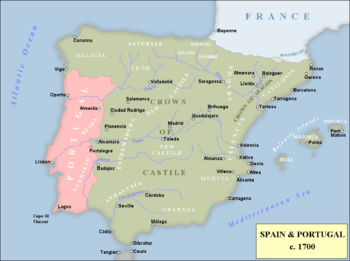
Victory in Spain was vital if Archduke Charles were to win the throne but the Habsburgs viewed Northern Italy and suppressing the Hungarian revolt as higher priorities. Anglo-Dutch involvement was driven by the mercantilist strategy of securing trade in the Mediterranean and gaining commercial access to the Spanish Empire. This made Spain more important to the Dutch and English than Austria and dependent on their support, a conflict that was never really solved.
Spain was a union between the Crowns of Castile and Aragon, [lower-alpha 15] with Aragon then divided into the Principality of Catalonia plus the Kingdoms of Aragon, Valencia, Majorca, Sicily, Naples and Sardinia. Majorca, Naples, Sicily and Sardinia declared for Philip in 1701; a mixture of anti-Castilian and anti-French sentiment meant Catalonia, most of Aragon and Valencia supported Archduke Charles but this simplifies a very complex reality.
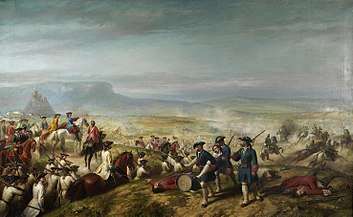
Anglo-Dutch strategy required a naval base in the area; the attack on Cádiz in September 1702 ended in failure but victory at Vigo Bay in October persuaded Peter II of Portugal to abandon the Bourbons and join the Grand Alliance in May 1703.[50] This gave the Allies access to Lisbon and in March 1704, the newly crowned Charles III of Spain arrived in Portugal to begin a land campaign.
In May 1704, a Bourbon army won a series of minor victories along the Spain/Portugal border, offset by the Allied capture of Gibraltar, a vital strategic possession. Attempts to retake it were defeated at the naval Battle of Málaga in August, with a land siege being abandoned in April 1705.[51]
In June 1705, the 'Pact of Genoa' between Catalan representatives and England opened a second front in the north-east; the loss of Barcelona and Valencia left Toulon as the only major port available to the Bourbons in the Western Mediterranean.[52] Philip tried to retake Barcelona in May 1706 but was repulsed, his absence allowing an Allied force from Portugal to enter Madrid and Zaragossa. The Allies could not be resupplied so far from their bases and had to withdraw; by November, Philip controlled Castile, Murcia and parts of Valencia.
Attempts to regain the initiative in 1707 ended with Allied defeats at Almansa in April and Toulon in August, once again restricting Archduke Charles to Catalonia. The British capture of Menorca in 1708 combined with possession of Gibraltar gave them control of the Western Mediterranean. By the end of 1708, British objectives had largely been achieved, Portugal and the Dutch Republic were financially exhausted while Austria refused to commit significant resources to putting Charles on the throne of Spain.
No peace without Spain; 1709–1713
By the end of 1708, the war had reached stalemate; the French had withdrawn from Northern Italy, with Austria gaining the Spanish possessions of Milan and Naples. In the Low Countries, Ramillies and Oudenarde gave the Maritime Powers control of the Spanish Netherlands and secured the borders of the Dutch Republic; in the Mediterranean, Britain's Royal Navy had achieved naval supremacy and permanent bases in Gibraltar and Menorca.
However, France's frontiers remained largely intact while the Grand Alliance had been unable to make any lasting progress in Spain, where Philip proved to be far more popular with the Spanish than the Austrian candidate Archduke Charles. Many of the objectives originally set out by the Grand Alliance in 1701 had been achieved but the victories of 1706 made them overconfident, resulting in the continuation of a war most participants wanted to end but could not.
Diplomacy
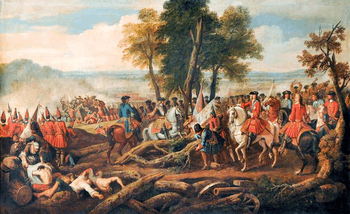
France opened informal discussions with the Dutch in 1705, viewing them as the most likely to favour a quick end to the war. Defeat at Ramillies increased this possibility by removing a direct military threat to the Dutch Republic and highlighting differences within the Alliance on the future of the Spanish Netherlands.[53] Ultimately, these made little progress since the Allies had agreed to negotiate jointly, not separately and they were unable to reach internal agreement on the terms.
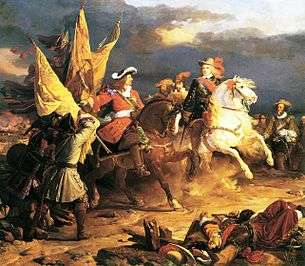
The winter of 1708 in Europe was one of the coldest on record, with widespread crop failures and famine exacerbated in France and Spain by a British naval blockade of grain imports. The French re-opened talks and in May 1709, the Allies presented the terms known as the Preliminaries of Hague; they included the demand Philip cede his throne to Archduke Charles without compensation and France assist in his removal by force if this was not done within two months.[54] This assumed Philip would abdicate on request and the Spanish accept Archduke Charles while seriously under-estimating France's ability to resist.[55] Louis was willing to abandon Spain but not make war on his own grandson; when it became public, the demand was considered so offensive that it strengthened French resolve to fight on.[56]
Marlborough now launched an offensive in Northern France which led to the Battle of Malplaquet on 11 September 1709 between an Allied army of 86,000 and a French of 75,000. Victory cost the Allies over 20,000 casualties, demonstrated the fighting ability of the French army remained intact and increased war-weariness both in Britain and the Dutch Republic, who suffered heavy losses.[57] This was compounded by the Bourbon recapture of Alicante in April and the defeat of an Anglo-Portuguese force at La Gudina in May.
Lack of progress accentuated the reality that the Allies no longer shared clear objectives, highlighted by Dutch exclusion from an agreement between Britain and Archduke Charles for trading rights in Spanish America. The British government compensated with the 1709 First Barrier Treaty; this gave the Dutch effective control of the Spanish Netherlands but was seen as detrimental to British commerce and increased domestic opposition.[58]
The Whigs had won the 1708 British general election by arguing military victory was the quickest road to peace but failure in France was followed by the same in Spain. In 1710, victories at Almenar and Saragossa enabled Archduke Charles to re-enter Madrid but he was again forced to retreat; by December, the Allies controlled only Catalonia after defeats at Brihuega and Villaviciosa. Whig policy had clearly failed and aided by the Sacheverell riots, the pro-peace Tories won a landslide victory in the 1710 election.[lower-alpha 16]
Negotiations


Negotiations resumed in March 1710 at Geertruidenberg but broke down due to the continued insistence France expel Philip by force if he refused to abdicate. The new British government confirmed its commitment to the war to prevent a credit crisis and reassure its Allies; despite the capture of Bouchain in September, decisive victory in Northern France continued to elude the Allies while an expedition against Quebec in French North America ended in disaster.[59]
The British political situation was simplified when Emperor Joseph died in April 1711 and Archduke Charles elected Emperor in October. The purpose of continuing the war was unclear, since union of Spain with Austria was as unwelcome as one with France and as the Tory propagandist Jonathan Swift pointed out, the 1701 Treaty made no reference to removing Philip.[lower-alpha 17] Even the Whigs had grown frustrated by the Habsburg tendency to put their interests first e.g. the 1707 Convention of Milan or the diversion of resources to capturing Naples in 1707.
The British secretly negotiated peace terms directly with France leading to the signing of the Preliminary Articles of London on 8 October 1711.[lower-alpha 18] These included French acceptance of the Act of Settlement and a guarantee the French and Spanish crowns would remain separate, while France undertook to ensure Spain ceded Gibraltar and Menorca and award the Asiento to Britain for 30 years.[60] Together with a commitment to the Dutch Barrier, these would form the basis of the Treaty of Utrecht.
Despite their annoyance at being excluded from the Anglo-French negotiations, the Dutch were financially exhausted by the enormous cost of the war and could not continue without British support. Charles VI rejected the idea of a peace conference; once the Dutch agreed to support it, he reluctantly agreed rather than be isolated but Habsburg opposition to the Treaty continued.[61]
The Peace of Utrecht

Within weeks of the conference opening, events threatened the basis of the peace agreed between Britain and France. First, the French presented proposals awarding the Spanish Netherlands to Max Emmanuel of Bavaria and a minimal Barrier, leaving the Dutch with little to show for their huge investment of money and men. Second, a series of deaths left Louis XIV's two year old great-grandson, the future Louis XV as heir, making Philip next in line and his immediate renunciation imperative.[62]
The Dutch and Austrians fought on, hoping to improve their negotiating position but the British government issued 'Restraining Orders' to Marlborough's replacement, the Duke of Ormonde, instructing him not to participate in offensive operations against the French.[63] These caused fury then and later with prominent Whigs urging the Hanoverian envoy in London to support military intervention by the future George I.[lower-alpha 19][64]
Prince Eugene captured Le Quesnoy in June and besieged Landrecies but was defeated at Denain on 24 July; the French went on to recapture Le Quesnoy and many towns lost in previous years, including Marchines, Douai and Bouchain.[65] The Dutch finally reached the end of their willingness and ability to continue the war.

On 6 June, Philip had announced his renunciation of the French throne; the British Tory government now offered the Dutch a revised Barrier Treaty, replacing that of 1709 which they rejected as overly generous. It was a significant improvement on the 1697 Barrier but ultimately subject to Austrian approval and the final terms were less beneficial.[66] Charles withdrew from the Conference when France insisted on a guarantee that Austria would not seek to acquire Mantua or Mirandola; he was supported by George, Elector of Hanover, who wanted France to withdraw their support for the Stuart heir James Francis. This meant neither Austria or the Empire signed the Treaty of Utrecht of 11 April 1713 between France and the other Allies; Spain made peace with the Dutch in June, then Savoy and Britain on 13 July 1713.
The treaties of Rastatt and Baden
Fighting continued on the Rhine but Austria was financially exhausted and after the loss of Landau and Freiburg in November 1713, Charles came to terms. The Treaty of Rastatt on 7 March 1714 confirmed Austrian gains in Italy, returned Breisach, Kehl and Freiburg, ended French support for the Hungarian revolt and agreed terms for the Dutch Barrier fortresses. Charles abandoned his claim to Strasbourg and Alsace and agreed to the restoration of the Wittelsbach Electors of Bavaria and Cologne, Max Emmanuel and Joseph Clemens. Article XIX of the treaty transferred sovereignty over the Spanish Netherlands to Austria.[67][68] On 7 September, the Holy Roman Empire joined the agreement by the Treaty of Baden; although Catalonia and Majorca were not finally subdued by the Bourbons until June 1715, the war was over.
Aftermath
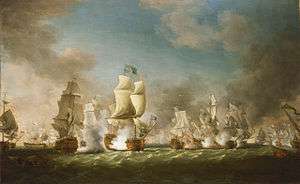
The Peace of Utrecht stipulated that "because of the great danger which threatened the liberty and safety of all Europe, from the too close conjunction of the kingdoms of Spain and France, [...] one and the same person should never become King of both kingdoms."[69] Some historians view this as a key point in the evolution of the modern nation state, while legal historian Randall Lesaffer also argues that it marks a significant milestone in the concept of collective security.[70]
Britain is usually seen as the main beneficiary, Utrecht marking the beginning of its rise to commercial domination of Europe.[71] In addition, the conflict left Austria, Britain, France, the Netherlands and Spain with unprecedented levels of government debt but only Britain managed to successfully find a way to finance it.[72]
Britain ended the war as the largest naval power in the world; France accepted the Protestant succession, ensuring a smooth inheritance by George I in August 1714 and ended their support for the Stuarts by the terms of 1716 Anglo-French Treaty.[73] Possession of Gibraltar and Menorca gave British control of the Western Mediterranean while gaining commercial access to Spanish America; resentment over this would lead to the 1739 Anglo-Spanish War.
Spain retained its independence, the majority of its Empire and Philip was confirmed as King but in return, ceded the Spanish Netherlands and most of their Italian possessions to Austria, Sicily to Savoy and Gibraltar and Menorca to Britain. The 1707 Nueva Planta decrees transferred powers to Madrid and largely abolished regional political structures.[lower-alpha 20][74] These reforms strengthened state finances and Spain recovered remarkably quickly; while British naval power prevented the capture of Naples and Sicily in 1718, Spain successfully re-occupied them in 1734.

Despite Charles' failure in Spain, Austria secured its position in Italy and Hungary while also acquiring the bulk of the Spanish Netherlands. While finances remained an enduring weakness of the devolved Habsburg state, even after reimbursing most of the expenses associated with the Dutch Barrier, the increased tax revenues helped fund a significant expansion of Austrian military forces.[75] However, their new maritime possessions in the Netherlands and in Italy proved difficult and expensive to defend, while increasing potential for conflict in an area where Austria traditionally relied on others for support. After 1714 this effectively meant Britain; only the Royal Navy prevented Spain recapturing Sicily in 1718 and the Kingdom of Naples was lost for good in 1734.
The historian Robert A. Kann claims the negative consequences of the war for Austria must be laid largely at the door of Charles VI's personal failings, in particular his excessive dynastic pride that overrode all other considerations.[76] Charles' obsession with ensuring his daughter's succession via the Pragmatic Sanction of 1713 consumed Austrian energy and money. This included Austria's involvement in peripheral conflicts like the 1733-1735 War of the Polish Succession, where most of the fighting actually took place on Austrian territory.[77]
Victory in the Austro-Turkish War of 1716–18 continued the trend of Habsburg focus shifting away from Germany and into South-East Europe. Their hold over the Empire continued to weaken, with Bavaria, Hanover, Prussia and Saxony pursuing their own policies; in 1742, Charles of Bavaria became the first non-Habsburg Emperor in over 300 years.
The huge effort made by the Dutch Republic meant it ended the war in 1713 effectively bankrupt, while the protection of the 1715 Barrier Treaty that had cost so much proved largely illusory.[78] In 1740, the fortresses were quickly overrun and Britain's promise of military support against any aggressor proved far more effective than the Barrier itself.[79] The debts incurred and the damage suffered by the Dutch merchant navy permanently affected their commercial and political strength and the Netherlands was superseded by Britain as the pre-eminent European mercantile power.[80]
Louis XIV died on 1 September 1715, with his five-year-old great-grandson reigning as Louis XV until 1774; on his deathbed, he is alleged to have admitted 'I have loved war too well.'[81] True or not, while the final settlement was far more favourable than the Allied offer of 1709, it is hard to see what Louis gained that had not already been achieved through diplomacy by February 1701. France remained strong but could not maintain its former dominance, particularly in relation to Britain; concern over this relative decline in military and economic terms was an underlying cause of the War of the Austrian Succession.[82]
Wider implications include the beginning of the rise of Prussia and Savoy while many of the participants were involved in the 1700-1721 the Great Northern War, with Russia becoming a European power for the first time as a result. Finally, while colonial conflicts were relatively minor and largely confined to the North American theatre or the so-called Queen Anne's War, they were to become a key element in future wars.
See also
| Wikimedia Commons has media related to War of the Spanish Succession. |
Footnotes
- ↑ Subsidiary conflicts in North America and elsewhere were largely the continuation of ongoing struggles for colonial territories unrelated to the issues in Europe.
- ↑ The 1707 Acts of Union united England and Scotland
- ↑ (in rebellion against Austria)
- ↑ The term generally used instead of 'Empire.'
- ↑ The Habsburgs were rulers of Austria and Hungary in their own right; Emperor of the Holy Roman Empire was technically an elected position but had been held by the Habsburgs since 1438.
- ↑ Until 1707, England and Scotland were separate countries under one monarch ie William but Treaties were signed by the King of Great Britain.
- ↑ Their main objection was France gaining Sicily, an important link in the lucrative Levant trade.
- ↑ England and Scotland were separate countries until 1707 but the Treaty was signed by William as King of Great Britain.
- ↑ Similar to the North African campaigns of 1940-42 where the British and German/Italians fought along the same coastal strip.
- ↑ The perceived tendency of the Austrian Habsburgs to agree concessions and then avoid implementation bred mistrust among their allies.
- ↑ The Crown of Aragon was divided into the Kingdoms of Aragon, Catalonia, Valencia, Majorca, Naples, Sicily, Malta and Sardinia.
- ↑ Without significant naval forces of its own, Austria could not take Sicily and the Kingdom was recaptured by Spain in 1734.
- ↑ These became part of France in 1860.
- ↑ Max Emmanuel remained a French general, fighting in many of the battles of 1705-08.
- ↑ Similar to England and Scotland.
- ↑ By this stage, British financial power was essential for the Allies to continue the war, hence the importance of British domestic politics.
- ↑ The most famous being his pamphlet titled The Conduct of the Allies.
- ↑ Also known as the Mesnager Convention.
- ↑ George I regarded those involved with deep suspicion and hostility; Ormonde, Henry St John, Viscount Bolingbroke, alleged architect of the Orders and others were effectively driven into exile and became prominent Jacobites.
- ↑ Aragon and Valencia were brought into the system in 1712, Catalonia and Majorca following in 1767.
References
- 1 2 3 4 5 6 7 Clodfelter 2017, p. 73.
- ↑ Falkner, James (2015). The War of the Spanish Succession (Kindle ed.). 4148-4181: Pen and Sword Military. ASIN B0189PTWZG.
- ↑ Hochedlinger, Michael (2003). Austria's Wars of Emergence, 1683-1797. Routledge. p. 171. ISBN 0582290848.
- ↑ Storrs, Christopher (2006). The Resilience of the Spanish Monarchy 1665-1700. OUP Oxford. pp. 6–7. ISBN 978-0199246373.
- ↑ Frey, Linda, Frey, Marsha (1995). The Treaties of the War of the Spanish Succession: An Historical and Critical Dictionary. Greenwood. pp. 191–192. ISBN 978-0313278846.
- ↑ Childs, John (1991). The Nine Years' War and the British Army, 1688-1697: The Operations in the Low Countries (2013 ed.). Manchester University Press. p. 1. ISBN 0719089964.
- ↑ I. D. White, "Rural Settlement 1500–1770", in M. Lynch, ed., Oxford Companion to Scottish History (Oxford: Oxford University Press, 2011), ISBN 0199693056, pp. 542–3.
- ↑ de Vries, Jan (2009). "The Economic Crisis of the 17th Century" (PDF). Journal of Interdisciplinary Studies. 40 (2): 151–194. Retrieved 7 April 2018.
- ↑ Meerts, Paul Willem (2014). Diplomatic negotiation: Essence and Evolution. http://hdl.handle.net/1887/29596: Leiden University dissertation. p. 168.
- ↑ Frey, Linda; Frey, Marsha, eds. (1995). The Treaties of the War of the Spanish Succession: An Historical and Critical Dictionary. Greenwood. p. 389. ISBN 978-0313278846.
- ↑ McKay, Derek, Scott, HM (1983). The Rise of the Great Powers 1648 - 1815 (The Modern European State System). Routledge. pp. 54–55. ISBN 978-0582485549.
- ↑ Ward, William,, Leathes, Stanley (1912). The Cambridge Modern History (2010 ed.). Nabu. p. 385. ISBN 978-1174382055.
- ↑ Ingrao, Charles (2000). The Habsburg Monarchy, 1618–1815 (2010 ed.). Cambridge University Press. p. 105. ISBN 978-0521785051.
- ↑ McKay, Derek, Scott, HM (1983). The Rise of the Great Powers 1648–1815 (The Modern European State System). Routledge. p. 55. ISBN 978-0582485549.
- ↑ Kamen, Henry (2001). Philip V of Spain: The King Who Reigned Twice. Yale University Press. p. 3. ISBN 978-0300180541.
- ↑ Onnekink, David (ed) Mijers, Esther (ed), Rule, John (2017). The Partition Treaties, 1698–1700; A European View in Redefining William III: The Impact of the King-Stadholder in International Context. Routledge. pp. 91–108. ISBN 978-1138257962.
- ↑ Onnekink, David (ed) Mijers, Esther (ed), Rule, John (2017). The Partition Treaties, 1698–1700; A European View in Redefining William III: The Impact of the King-Stadholder in International Context. Routledge. pp. 91–108. ISBN 978-1138257962.
- ↑ Falkner, James (2015). The War of the Spanish Succession 1701-1714 (Kindle ed.). Pen and Sword. pp. 508–568. ISBN 9781473872905.
- ↑ Gregg, Edward (1980). Queen Anne (Revised) (The English Monarchs Series) (2001 ed.). Yale University Press. p. 126. ISBN 978-0300090246.
- ↑ Somerset, Anne (2012). Queen Anne; the Politics of Passion. Harper. p. 166. ISBN 978-0007203765.
- ↑ Falkner, James (2015). The War of the Spanish Succession 1701-1714 (Kindle ed.). Pen and Sword. p. 96. ISBN 9781473872905.
- ↑ Thompson, RT (1973). Lothar Franz von Schönborn and the Diplomacy of the Electorate of Mainz:. Springer. pp. 158–160. ISBN 978-9024713462.
- ↑ Somerset, Anne (2012). Queen Anne; the Politics of Passion. Harper. pp. 166–167. ISBN 978-0007203765.
- ↑ Israel, Jonathan (1989). Dutch Primacy in World Trade, 1585-1740 (1990 ed.). Oxford University Press. pp. 197–199. ISBN 978-0198211396.
- ↑ Somerset, Anne (2012). Queen Anne; the Politics of Passion. Harper. p. 167. ISBN 978-0007203765.
- ↑ Somerset, Anne (2012). Queen Anne; the Politics of Passion. Harper. p. 168. ISBN 978-0007203765.
- ↑ Wolf, John (1968). Louis XIV (1974 ed.). WW Norton & Co. p. 514. ISBN 978-0393007534.
- ↑ Schmidt Voges, Inken (ed), Solana Crespo, Ana (ed) (2017). New Worlds?: Transformations in the Culture of International Relations Around the Peace of Utrecht (Politics and Culture in Europe, 1650-1750). Routledge. p. 2. ISBN 978-1472463906.
- ↑ Rothbard, Murray. "Mercantilism as the Economic Side of Absolutism". Mises.org. Good summary of the concept. Retrieved 7 April 2018.
- ↑ Schaeper, Thomas (March 1986). "French and English Trade after Utrecht". Journal for Eighteenth Century Studies. 9 (1): 1. doi:10.1111/j.1754-0208.1986.tb00117.x.
- ↑ Childs, John (1991). The Nine Years' War and the British Army, 1688-1697: The Operations in the Low Countries (2013 ed.). Manchester University Press. p. 2. ISBN 978-0719089961.
- ↑ Shinsuke, Satsuma (2013). Britain and Colonial Maritime War in the Early Eighteenth Century. Overview of arguments used: Boydell Press. p. 37 passim. ISBN 978-1843838623.
- ↑ Ostwald, James, Murray & Sinnreich (ed) (2014). Creating the British way of war: English strategy in the War of the Spanish Succession. in; Successful Strategies: Triumphing in War and Peace from Antiquity to the Present: Cambridge University Press. pp. 100–129. ISBN 978-1107633599.
- ↑ Ingrao: In Quest, 39–40; Veenendaal: The War of the Spanish Succession in Europe, 410–1
- ↑ Storrs, Christopher. "The Decline of Spain in the Seventeenth Century" (PDF). State Papers Online. Gale;Cengage Learning. Retrieved 7 April 2018.
- ↑ Jon Cowans (2003). Modern Spain: A Documentary History. U. of Pennsylvania Press. pp. 26–27. ISBN 978-0-8122-1846-6.
- ↑ Dhondt, Frederik, De Ruysscher, Capelle, K et al. (eds.) (2015). Historical Exempla in Legal Doctrine: Vattel and Réal de Curban on the War of the Spanish Succession. in Legal history, moving in new directions: Maklu. pp. 16–17. ISBN 9789046607589.
- ↑ Lynn, John (1999). The Wars of Louis XIV 1667-1714. Longman. pp. 270–271. ISBN 978-0582056299.
- ↑ Lynn, John (1999). The Wars of Louis XIV 1667-1714. Longman. pp. 276–277. ISBN 978-0582056299.
- ↑ Falkner, James (2015). The War of the Spanish Succession 1701-1714 (Kindle ed.). 1302: Pen and Sword. ISBN 9781473872905.
- ↑ Sundstrom, Roy A (1992). Sidney Godolphin: Servant of the State. EDS Publications Ltd. p. 196. ISBN 978-0874134384.
- ↑ Symcox, Geoffrey (1985). Victor Amadeus; Absolutism in the Savoyard State, 1675-1730. University of California Press. p. 155. ISBN 978-0520049741.
- ↑ Lynn, John (1999). The Wars of Louis XIV, 1667-1714 (Modern Wars In Perspective). Longman. p. 275. ISBN 978-0582056299.
- ↑ Lynn, John (1999). The Wars of Louis XIV, 1667-1714 (Modern Wars In Perspective). Longman. pp. 280–281. ISBN 978-0582056299.
- ↑ Ingrao: In Quest, 123; McKay: Eugene, 73
- ↑ Lynn, John (1999). The Wars of Louis XIV, 1667-1714 (Modern Wars In Perspective). Longman. pp. 286–294. ISBN 978-0582056299.
- ↑ Lynn, John (1999). The Wars of Louis XIV, 1667-1714 (Modern Wars In Perspective). Longman. pp. 298–299. ISBN 978-0582056299.
- ↑ Holmes, Richard (2008). Marlborough: England's Fragile Genius. Harper. pp. 347–349. ISBN 978-0007225729.
- ↑ Lynn, John (1999). The Wars of Louis XIV, 1667-1714 (Modern Wars In Perspective). Longman. pp. 320–323. ISBN 978-0582056299.
- ↑ Francis, AD (May 1965). "Portugal and the Grand Alliance". Historical Research. 38 (97): 71–93. doi:10.1111/j.1468-2281.1965.tb01638.x.
- ↑ Lynn, John (1999). The Wars of Louis XIV 1667-1714. Longman. p. 296. ISBN 978-0582056299.
- ↑ Lynn, John (1999). The Wars of Louis XIV 1667-1714. Longman. p. 302. ISBN 978-0582056299.
- ↑ Bromley, JS (1970). The New Cambridge Modern History: Volume 6, The Rise of Great Britain and Russia (1979 ed.). Cambridge University Press. p. 446. ISBN 978-0521293969.
- ↑ Ward, William,, Leathes, Stanley (1912). The Cambridge Modern History (2010 ed.). Nabu. pp. 422–423. ISBN 978-1174382055. Retrieved 14 May 2018.
- ↑ Kamen, Henry (2001). Philip V of Spain: The King Who Reigned Twice. Yale University Press. pp. 70–72. ISBN 978-0300180541.
- ↑ Ward, William,, Leathes, Stanley (1912). he Cambridge Modern History (2010 ed.). Nabu. p. 424. ISBN 978-1174382055. Retrieved 14 May 2018.
- ↑ Gregg, Edward (1980). Queen Anne (Revised) (The English Monarchs Series) (2001 ed.). Yale University Press. p. 289. ISBN 978-0300090246.
- ↑ Gregg, Edward (1980). Queen Anne (Revised) (The English Monarchs Series) (2001 ed.). Yale University Press. p. 289. ISBN 978-0300090246.
- ↑ Simms, Brendan (2008). Three Victories and a Defeat: The Rise and Fall of the First British Empire, 1714–1783. Penguin. pp. 60–64. ISBN 978-0140289848.
- ↑ Bromley, JS (1970). The New Cambridge Modern History: Volume 6, The Rise of Great Britain and Russia (1979 ed.). Cambridge University Press. pp. 459–460. ISBN 978-0521293969.
- ↑ Dadson, Trevor (ed), Thompson, Andrew (2014). The Utrecht Settlement and its Aftermath in Britain, Spain and the Treaty of Utrecht 1713-2013. Routledge. p. 63. ISBN 978-1909662223.
- ↑ Somerset, Anne (2012). Queen Anne: The Politics of Passion. Harper Press. p. 470. ISBN 978-0007203765.
- ↑ Gregg, Edward (1980). Queen Anne (Revised) (The English Monarchs Series) (2001 ed.). Yale University Press. p. 354. ISBN 978-0300090246.
- ↑ Somerset, Anne (2012). Queen Anne: The Politics of Passion. Harper Press. p. 477. ISBN 978-0007203765.
- ↑ Holmes, Richard (2008). Marlborough: England's Fragile Genius. Harper. p. 462. ISBN 978-0007225729.
- ↑ Myers (1917). "Violation of Treaties: Bad Faith, Nonexecution and Disregard". The American Journal of International Law. 11 (4): 799–829 passim.
- ↑ Klaus Malettke, Les relations entre la France et le Saint-Empire au XVIIe siècle, Honoré Champion, Paris, 2001, p. 645–647.
- ↑ Frey, Linda; Frey, Marsha, eds. (1995). The Treaties of the War of the Spanish Succession: An Historical and Critical Dictionary. Greenwood. pp. 374–375. ISBN 978-0313278846.
- ↑ Article II, Peace and Friendship Treaty of Utrecht.
- ↑ Lesaffer, Randall. "The peace of Utrecht and the balance of power". OUP Blog. Retrieved 5 May 2018.
- ↑ Pincus, Steven. "Rethinking Mercantilism: Political Economy, The British Empire and the Atlantic World in the 17th and 18th Centuries" (PDF). Warwick University: 7–8. Retrieved 10 May 2018.
- ↑ Carlos, Ann (author) Neal, Larry (author), Wandschneider, Kirsten (author) (2006). "The Origins of National Debt: The Financing and Re-financing of the War of the Spanish Succession" (PDF). International Economic History Association: 2. Retrieved 6 September 2018.
- ↑ Szechi, Daniel (1994). The Jacobites: Britain and Europe, 1688-1788 (First ed.). Manchester University Press. pp. 93–95. ISBN 978-0719037740.
- ↑ Vives Vi, Jaime (1969). An Economic History of Spain. Princeton University Press. p. 591. ISBN 978-0691051659. Retrieved 8 April 2018.
- ↑ Falkner, James (2015). The War of the Spanish Succession (Kindle ed.). 4173-4181: Pen and Sword Military. ASIN B0189PTWZG.
- ↑ Robert A. Kann, A History of the Habsburg Empire, 1526–1918, University of California Press, 1980 (1974), p. 88–89.
- ↑ Anderson, MS (1995). The War of Austrian Succession 1740-1748. Routledge. pp. 7–11. ISBN 978-0582059504.
- ↑ Kubben, Raymond (2011). Regeneration and Hegemony; Franco-Batavian Relations in the Revolutionary Era 1795-1803. Martinus Nijhoff. p. 148. ISBN 978-9004185586.
- ↑ Ward, Adolphus William (1922). The Cambridge History of British Foreign Policy, Volume 2 (2011 ed.). Cambridge University Press. p. 57. ISBN 978-1108040136.
- ↑ Dadson, Trevor (ed), Elliott, John (2014). The Road to Utrecht in Britain, Spain and the Treaty of Utrecht 1713-2013. Routledge. p. 8. ISBN 978-1909662223.
- ↑ Colville, Alfred (1935). Studies in Anglo-French History During the Eighteenth, Nineteenth and Twentieth Centuries (2018 ed.). Forgotten Books. p. 149. ISBN 978-1528022392.
- ↑ Lynn, John (1999). The Wars of Louis XIV 1667-1714. Longman. pp. 361–362. ISBN 978-0582056299.
Bibliography
- Clodfelter, M. (2017). Warfare and Armed Conflicts: A Statistical Encyclopedia of Casualty and Other Figures, 1492-2015 (4th ed.). Jefferson, North Carolina: McFarland. ISBN 978-0786474707.
- Bromley, J. S (ed.). The New Cambridge Modern History VI: The Rise of Great Britain and Russia 1688–1725. Cambridge University Press, 1971. ISBN 0521075246
- Burton, Ivor F. The Captain-General: The Career of John Churchill, Duke of Marlborough, from 1702 to 1711. Constable & Co Ltd., 1968. ISBN 0094561001
- Chandler, David G. Marlborough as Military Commander. Spellmount Ltd, 2003. ISBN 186227195X
- Clark, George. From the Nine Years' War to the War of the Spanish Succession in J. S. Bromley (ed.) The New Cambridge Modern History, VI, 381–409.
- Falkner, James. The War of the Spanish Succession 1701 – 1714 (2015).
- Francis, David. The First Peninsular War 1702–1713. Ernest Benn Limited, 1975. ISBN 0510002056
- Frey, Linda and Marsha Frey, The Treaties of the War of the Spanish Succession: An Historical and Critical Dictionary (1995) online; covers diplomatic, economic, & military roles and battles
- Godinho, Vitorino Magalhães. Portugal and Her Empire, 1680–1720 in J. S. Bromley (ed.) The New Cambridge Modern History, VI, 509–40.
- Gregg, Edward. Queen Anne. Yale University Press, 2001. ISBN 0300090242
- Hattendorf, John, B. Alliance, Encirclement, and Attrition: British Grand Strategy in the War of the Spanish Succession, 1702–1713, in Paul Kennedy (ed.) Grand Strategies in War and Peace, 11–29. Yale University Press, 1991. ISBN 0300049447
- Hattendorf, John, B. England in the War of the Spanish Succession: A Study of the English View & Conduct of Grand Strategy, 1702–1712 (1987)
- ——— England in the War of the Spanish Succession: A Study in the English View and Conduct of Grand Strategy, 1701–1713. (Ph.D.), 1979. University of Oxford
- Hatton, Ragnhild. George I. Yale University Press, 2001. ISBN 0300088833
- Hill, Brian W. Robert Harley: Speaker, Secretary of State and Premier Minister. Yale University Press, 1988. ISBN 0300042841
- Holmes, Geoffrey (ed.). Britain after the Glorious Revolution 1689–1714. The Macmillan Press Ltd, 1969. ISBN 0333106024
- Hugill, J. A. C. No Peace Without Spain. The Kensal Press, 1991. ISBN 094604158X
- Hussey, R. D and Bromley, J. S. The Spanish Empire under Foreign Pressures, 1688–1715 in J. S. Bromley (ed.) The New Cambridge Modern History, VI, 343–80
- Ingrao, Charles. In Quest and Crisis: Emperor Joseph I and the Habsburg Monarchy. Purdue University Press, 1979. ISBN 0911198539
- ——— The Habsburg Monarchy: 1618–1815. Cambridge University Press, 1994. ISBN 0521389003
- Israel, Jonathan I.. The Dutch Republic: Its Rise, Greatness, and Fall. Clarendon Press, 1998. ISBN 0198207344
- ____ "Commerce, Religion, and World Politics: Sephardi Jewry and the Struggle for the Spanish Succession (1700–1714)" in Diasporas within a Diaspora: Jews, Crypto-Jews, and the World of Maritime Empires (1540–1740). Leiden: Brill 2002, pp. 533–566. ISBN 90-04-12765-8.
- Jones, J. R. Marlborough. Cambridge University Press, 1993. ISBN 0521375932
- Kamen, Henry. Philip V of Spain: The King who Reigned Twice. Yale University Press, 2001. ISBN 0300087187
- ——— The War of Succession in Spain 1700–15. Weidenfeld and Nicolson, 1969. ISBN 029717777X
- Lenman, Bruce. Britain's Colonial Wars 1688–1783. Longman, 2001. ISBN 0582424011
- Lynn, John A. The Wars of Louis XIV 1667–1714. Longman, 1999. ISBN 0582056292
- MacLachlan, A. D. The Road to Peace 1710–13, in G. Holmes (ed.) Britain after the Glorious Revolution 1689–1714, 197–215
- McKay, Derek. Prince Eugene of Savoy. Thames and Hudson Ltd, 1977. ISBN 0500870071
- McKay, Derek and Scott, H. M. The Rise of the Great Powers: 1648–1815. Longman, 1984. ISBN 0582485541
- Ostwald, Jamel M. Creating the British Way of War: English Strategy in the War of the Spanish Succession, in Williamson Murray (ed.), Richard Hart Sinnreich (ed.) Successful Strategies: Triumphing in War and Peace from Antiquity to the Present, 100–29. Cambridge University Press, 2014. ISBN 9781107633599
- ——— The 'Decisive' Battle of Ramillies, 1706: Prerequisites for Decisiveness in Early Modern Warfare. The Journal of Military History 62 (July 2000): 649–78
- Pitt, H. G. The Pacification of Utrecht in J. S. Bromley (ed.) The New Cambridge Modern History, VI, 446–79
- Rodger, N.A.M. The Command of the Ocean: A Naval History of Britain 1649–1815. Penguin Group, 2006. ISBN 0141026901
- Scouller, R. E. The Armies of Queen Anne. Oxford University Press, 1966. ISBN 0198213433
- Simms, Brendan. Three Victories and a Defeat: The Rise and Fall of the First British Empire. Penguin, 2008. ISBN 9780140289848
- Spielman, John. Leopold I of Austria. Thames and Hudson Ltd, 1977. ISBN 0500870055
- Storrs, Christopher. The Resilience of the Spanish Monarchy 1665–1700. Oxford University Press, 2006. ISBN 0199246378
- ——— War, Diplomacy and the Rise of Savoy, 1690–1720. Cambridge University Press, 1999. ISBN 0521551463
- Stoye, J. W. The Austrian Habsburgs, in J. S. Bromley (ed.) The New Cambridge Modern History, VI, 572–607
- Symcox, Geoffrey. Victor Amadeus II: Absolutism in the Savoyard State 1675–1730. Thames & Hudson Ltd, 1983. ISBN 0500870101
- Trevelyan, G. M. England under Queen Anne. 3 volumes. London, 1930–34
- Veenendaal, A. J. The Opening Phase of Marlborough's Campaign of 1708 in the Netherlands. History, 35 (Feb–June 1950): 34–48
- ——— The War of the Spanish Succession in Europe, in J. S. Bromley (ed.) The New Cambridge Modern History, VI, 410–45
- Whaley, Joachim. Germany and the Holy Roman Empire, Volume II: The Peace of Westphalia to the Dissolution of the Reich, 1648–1806. Oxford University Press, 2012.
- Wolf, John B. The Emergence of the Great Powers: 1685–1715. Harper & Row, 1962. ISBN 978-0-06-139750-9
- ——— Louis XIV. W. W. Norton & Company, 1968. ISBN 0575000880
